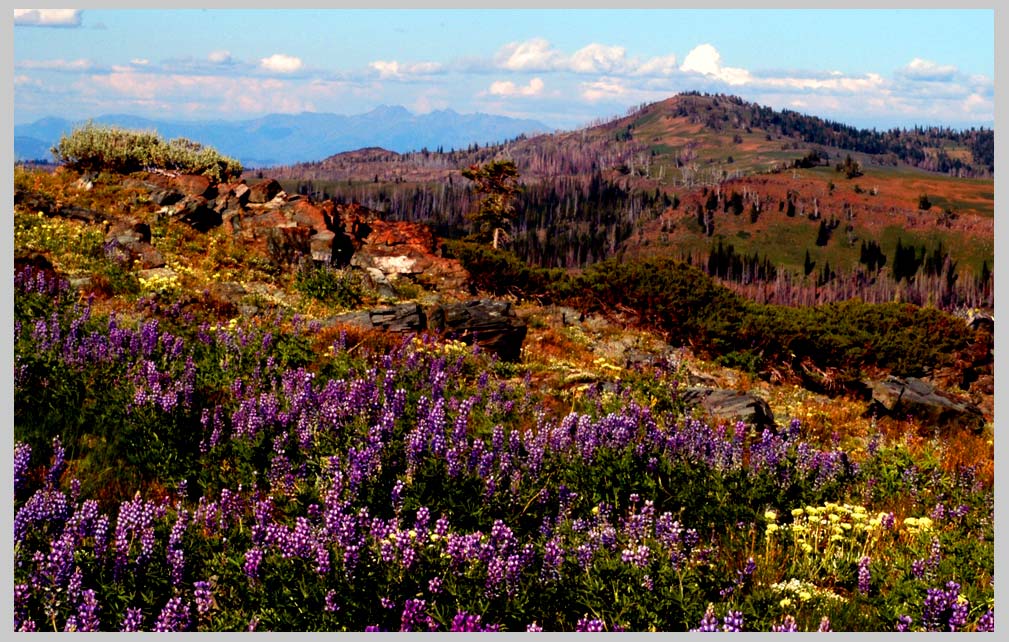

Canyon Country, Above East Pine Reservoir (lupine flowering), view [ click photo for next . . . ]
east northeast with early evening light . . .


Canyon Country, Above East Pine Reservoir (lupine flowering), view [ click photo for next . . . ]
east northeast with early evening light . . .
TOPO of area above Norway
Basin, pictured above. What I call MC
Ridge, a natural divide between the High
Wallowas to the west, and Canyon Country
to the east, at 2400 m., (top left on topo)
is where the photo was made. It also marks
the side of the Wallowas that is evidently
getting hardest hit by climate change. Northeast
of the divide, in my view, things are getting hotter
and drier. And more prone to burn.View for yourself why I call this MC
Ridge, a natural divide between the High
Wallowas to the west, and Canyon Country
too the west, at 2400 m. These two photos
were made at the same time, exactlly
the same place. All I did was turn my
tripod 180 degrees to face west southwestt.
This is the eastern boundary of where
I do most of my fieldwork in Wallowas.
On the road in the Northwest of America.
NEVER HEARD BEFORE
I awoke to new
stars, to the sound
of a bird:—
never heard before.
ON THE NECESSITY OF ROADLESS AREAS (II)
It is true: once a road is built, it frequently becomes easier and easier
to get to places that are less and less worth going to. If it can be said
that roads have a tendency to bring out the worst in people—the noisy
grind of greed and self-centered haste—then perhaps paths bring out
the best, a kind of waste-not-want-not of a rugged, but increasingly
rare spirit of self-reliance. One, a sharp-edged knife that rips apart the
fabric of forest and meadow; the other, a single thread which in the
walking weaves itself seamlessly back into the natural world. Clearly,
we obviously need good, well-designed roads. But even more we need
the wisdom of natural limits which tells us when not to build them.
THERE’S A CERTAIN SOUND
THE WIND MAKES—a prose poem
There’s a certain sound the wind makes in the tall pines of steep
slopes, where mountains wear winds like strings of braided crystals. I
sit on a rock to rest a while, motionless center of the world about me,
and am amazed to hear the low, resonant train of sound cut a wide yet
distinct swath down, around, and back up the late summer mountain.
This is a sound that begins not with silence, but with the icy periphery
of human time when we slowly began to walk on two feet. From this
moment on, the wind, who has always been something of a stern and
demanding elder, has been reminding us in a persistent voice: “You,
upright one.” it calls. “It is time. It is time. You have lost your fur and
now go naked in the world. It is time to find safe shelter from the sure
and certain coming of winter’s snow and deep cold of darkness. It is
time. It is time.” So we listen, and are reminded—once again.
TOO MANY VARIABLES
We shape the world and the world shapes us.
To master the complex, keep things simple.
To keep things simple, keep the number of variables
to but a single dial.
Turned all the way down, the dial produces the sleep
of rigid dogma; turned all the way up, it produces
the runaway confusion of random noise.
Better to keep things focused on the
clear limits of the middle way.
THE LITTLE CLAVIER please preview 150 of 631 pages
w/ my black & white photography [opens in new window]
All Photographs & texts by Cliff Crego © 1999 -2011 picture-poems.com
(created: V.27.2011)